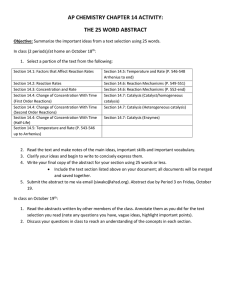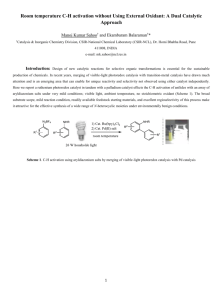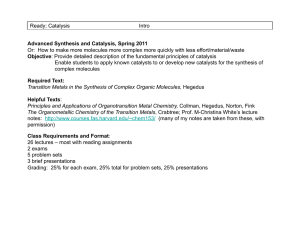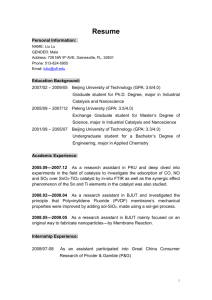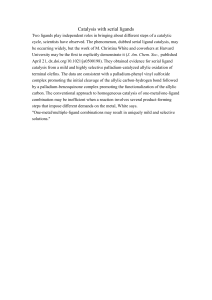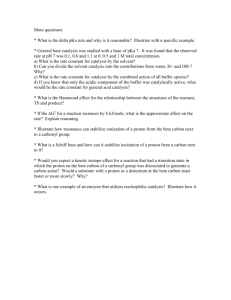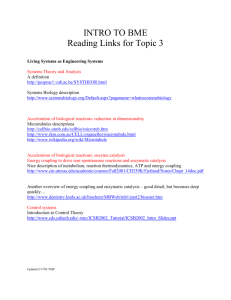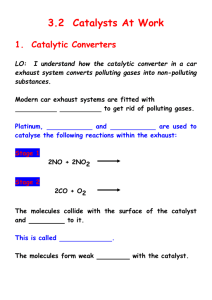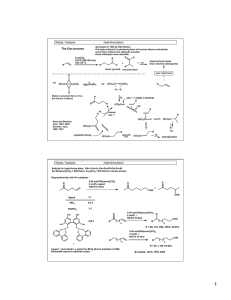Ready; Catalysis Intro
advertisement
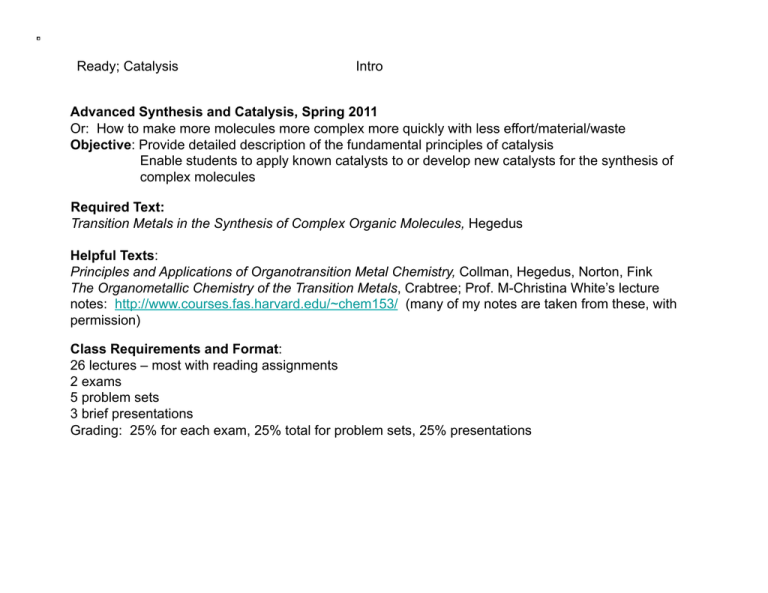
Ready; Catalysis Intro Advanced Synthesis and Catalysis, Spring 2011 Or: How to make more molecules more complex more quickly with less effort/material/waste Objective: Provide detailed description of the fundamental principles of catalysis Enable students to apply known catalysts to or develop new catalysts for the synthesis of complex molecules Required Text: Transition Metals in the Synthesis of Complex Organic Molecules, Hegedus Helpful Texts: Principles and Applications of Organotransition Metal Chemistry, Collman, Hegedus, Norton, Fink The Organometallic Chemistry of the Transition Metals, Crabtree; Prof. M-Christina White’s lecture notes: http://www.courses.fas.harvard.edu/~chem153/ (many of my notes are taken from these, with permission) Class Requirements and Format: 26 lectures – most with reading assignments 2 exams 5 problem sets 3 brief presentations Grading: 25% for each exam, 25% total for problem sets, 25% presentations Brief presentations. This assignment serves three purposes. To successfully complete it, you will need to (1) diligently read the current literature and identify the most practically or mechanistically important papers (2) critically evaluate a selected paper (3) prepare a wellresearched, insightful analysis of the paper you choose. Assignment: From the current literature (2009+) select a publication describing important advances in the field of catalysis. The paper should be related to the topic(s) that we are discussing in class. Present a brief (~5 min) talk focused on the paper. These should be done on the white board unless complex figures need to be projected. The overview should include the following items: Background: put this paper into context. What question are the trying to answer? What problem are they trying to solve? What answers/solutions have appeared previously. Describe relevant result from the authors’ lab as well as from other groups. Results: Describe the authors’ approach, results and conclusions. Analysis/Proposals: Critically analyze the paper. Does their data support their conclusions? Are their results truly significant or just a parlor trick? Imagine you are the author. What’s next? What experiments do you propose to address questions raised/left unanswered by the results in the paper. How could you expand or apply the approach or information from the this paper to other problems? Think about both immediate and long-term directions. The ‘Highlights’ section of Angewante Chemie is a good model for the style of presentation. You will give three of these presentations throughout the semester according to the schedule provided. Feel free to consult me, Prof Chen or Prof De Brabander on your paper selection. Ready; Catalysis Intro Some useful definitions: Catalyst: a substance that increases the rate of a reaction but is not changed by the reaction. • Light, heat, stirring, sonication and fire are not catalysts (they are not substances) • The definition does not say anything about stoichiometry, but in practice, less that 1 equiv (‘catalytic amounts’) of a catalyst is usually used. • A catalyst can only change rate, not thermodynamics. Corollary: A catalyst will increase the forward and reverse reaction • A catalyst can (and usually does) change the mechanism TON: turn over number. Moles product formed per mole catalyst, a measure of catalyst stability TOF: turn over frequency. Number of moles product per mole catalyst per unit time. A measure of catalyst efficiency. Inhibitor: A substance that decreases the TOF. Can be competitive (aka reversible) or non-competitive (not reversible, usually covalent modification of catalyst, AKA poison). E.e.: enantiomeric excess. Measurement of optical purity = %R-%S = (R-S)/(R+S) E.r.: enantiomeric ratio. Measurement of optical purity = R:S. Note value of e.r. always looks higher than ee (94:6 vs 88% ee) e.r. less common, but more intuitive (e.r. reflects GC or HPLC reading; ee reflects optical rotation measurement) Ready; Catalysis Advantages of Catalysis: $$$$ Faster reaction rate Milder reaction conditions Control of reaction selectivity Otherwise impossible reactions Environmental concerns Intro [O] = mCBPA, $80/mol [O] = H2O2, $1.80/mol Ready; Catalysis Classes of Catalysis Homogeneous Heterogeneous Intro Most often used class for small scale synthesis Very important for large scale Pd/C (hydrogenations) Zeolites (separations, oxidations) Amberlyst (solid acid) Supported metals (Haber process: NH3 synthesis; FischerTropsch: hydrocarbons from CO and H2 Polymer bound Many papers, few applications Phase transfer Biological Enzymes, catalytic antibodies Ready; Catalysis Intro Asymmetric Catalysis Important points Note R and S product have same energy, and uncatalyzed pathway has same ΔG‡ for both For good ee (%S-%R), need big ΔΔG‡(R-S). (Approx 1.4 kcal/mol per order of magnitude diff in ratio. E.g., 1.4 kcal = 91:9 = 82% ee, 2.8 = 99% ee) Catalyzed pathways are usually mechanistically more complex than uncatalyzed pathways • Small ΔΔG‡ required for good ee, esp compared to strength of C-C bond (~50-85 kcal/mol) or even H-bond (2-10 kcal/mol) • Still, very hard to get good ee. • Diminishing returns: 0 1.4 kca/mol: ~80% increase; 1.4 2.8: ~20% increase; 2.8 4.2 ~1% increase • Figure from Organotransitionmetal Chemistry, Hartwig Ready; Catalysis Intro Classes of Asymmetric Catalysis Reaction at prochiral centers: cat. Zn(OTf)2 Et3N O + R' R cat Ph OH Carreira, JACS, 2001, 9687 R Me R' NMe2 HO Desymmetrization modified cinchona alkaloid O O + MeOH CO2H R3N* Li Deng, JACS, 2000, 9542 95% y 98% ee O Stereoconvergent Processes CO2Me O O Me + (±)- (BINAP)Pd(0) Ar-BrH Me Buchwald, JACS, 1998, 1918 Ar LiN(SiMe3)3 Kinetic Resolution N N Co t-Bu O O (±)R O X + H2O t-Bu t-Bu 0.1 - 2 mol% t-Bu HO OH R 86-98% ee up to 50% y O + R 98-99% ee 29-44% y Jacobsen, Science, 1997, 277, 936 Some Examples of Asymmetric Catalysis are well Understood… Evans, JACS, 2007 …but Some Examples are not Understood Well Shibasaki, JACS, 2006 Ready; Catalysis Intro-7 Kinetic Resolutions Ee of substrate increases with conversion – can get as high as you want, but at the expense of yield Ee of product decreases with conversion. Recovered Substrate Reaction Product Ready; Catalysis Intro-8 Dynamic Kinetic Resolution Noyori, JACS, 1989, 9134 Parallel Kinetic Resolution Criteria for useful KR’s: Rac substrate cheap, enatio enriched substrate hard to make Can achieve theoretical ee’s Catalyst is accessible, selective and reactive (low loadings) Substrate and product easy to separate Product is useful Resolving agent is cheap Need extremely high ee’s
